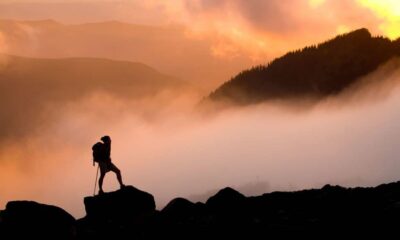Gadgets
Don’t even think about hiking on a glacier without a guide

Glaciers are awe-inspiring natural formations, massive sheets of ice that can extend for miles and vary in thickness from a few yards to thousands of feet. Many adventurous travelers dream of hiking on a glacier, but despite their appearance of stability, glaciers can be quite dangerous.
Take, for example, the Athabasca Glacier in Alberta, Canada, one of North America’s most popular glaciers. Guides often caution solo hikers about hidden dangers like crevasses and icy rivers lurking beneath the surface. One misstep could lead to serious injury or worse. It’s essential to hire a guide or have extensive training and experience before attempting to walk on a glacier.
Glacier science
Contrary to their appearance as solid and unchanging structures, glaciers are dynamic entities that constantly shift, move, and evolve. Maria Intxaustegi, a mountaineering guide, explains that glaciers are far from static and undergo continuous changes, including receding and growing.
According to Tim Patterson, a certified guide, navigating glacier terrain requires specialized knowledge and skills beyond what most people possess. Proper training and awareness are essential for safe glacier exploration.
Glaciers form over centuries as snow compacts into ice. They move down valleys as frozen rivers, changing the landscape as they advance or retreat. Despite their slow pace, glaciers can grow or shrink dramatically within a year due to factors like snowfall and temperature changes.
Climate change has caused many glaciers worldwide to retreat rapidly. Whether advancing or receding, glaciers reshape the land as they move and reveal potential dangers lurking beneath the surface.
Beware of sneaky crevasses
One of the most hazardous aspects of glaciers is the presence of crevasses, fractures in the ice that can open up unexpectedly due to glacier movement. These hidden gaps can range from shallow to deep and pose a significant risk to hikers. Even a small crevasse can result in serious injuries or worse if not detected in time.
Identifying and avoiding crevasses requires a deep understanding of snow and ice science. Traveling on glaciers safely demands both education and experience to mitigate the risk of falling into these hidden hazards.
In addition to crevasses, glaciers can contain other hidden dangers.
Glacial mills
Under-ice water features known as millwells or moulin can form when surface water creates vertical shafts in the ice. These waterways can be narrow and lead to streams beneath the glacier, posing a serious threat to hikers who may unknowingly step into them.
Millwells can change rapidly due to water flows, creating unseen hazards for even experienced hikers. Stories of individuals narrowly escaping these dangerous features serve as a reminder of the risks associated with glacier exploration.
Other hazards
In addition to crevasses and millwells, glaciers present other risks such as rockfalls, flooding, ice falls, and challenging terrain that can catch explorers off guard. Underestimating the dangers of wilderness landscapes can lead to dangerous situations for unprepared hikers.
Find your glacier guide
Despite the risks, glacier-based adventures can be thrilling and rewarding. Hiring a knowledgeable guide is essential for ensuring a safe and enjoyable experience on a glacier. In contrast, many glacier-rich destinations have a plethora of guides and guide companies available. To ensure you choose a reputable company that is knowledgeable about safe travel on ice, look for guides with certifications and experience in glaciated terrain, particularly in glacier travel and crevasse rescue training.
These guides can not only lead you safely across the ice but also take you to hidden gems you may not discover on your own, educate you about the landscape, and share fascinating stories as you explore. Remember to always go with someone who is knowledgeable and experienced to ensure a safe and enjoyable experience.
-

 Destination8 months ago
Destination8 months agoSingapore Airlines CEO set to join board of Air India, BA News, BA
-

 Breaking News10 months ago
Breaking News10 months agoCroatia to reintroduce compulsory military draft as regional tensions soar
-

 Gadgets3 months ago
Gadgets3 months agoSupernatural Season 16 Revival News, Cast, Plot and Release Date
-

 Tech News12 months ago
Tech News12 months agoBangladeshi police agents accused of selling citizens’ personal information on Telegram
-

 Productivity11 months ago
Productivity11 months agoHow Your Contact Center Can Become A Customer Engagement Center
-

 Gadgets3 weeks ago
Gadgets3 weeks agoFallout Season 2 Potential Release Date, Cast, Plot and News
-

 Breaking News10 months ago
Breaking News10 months agoBangladesh crisis: Refaat Ahmed sworn in as Bangladesh’s new chief justice
-

 Toys12 months ago
Toys12 months ago15 of the Best Trike & Tricycles Mums Recommend























